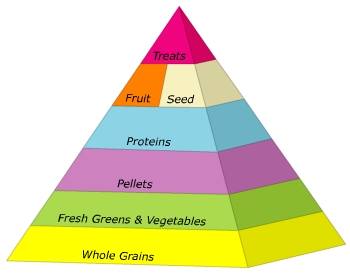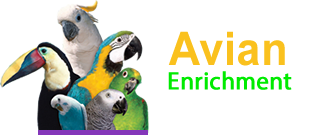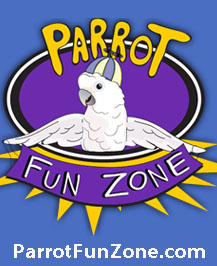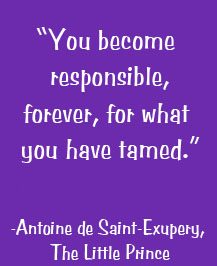The following diagram illustrates the relative proportions of grains, vegetables, fruits, pellets, seeds and treats that should be the basis of a bird's diet.

Whole Grains (25 - 40%)
Whole grains contain all elements of the kernel: bran, germ and endosperm. The bran and germ contain a variety of health-enhancing components including dietary fiber, phytochemicals, vitamins, trace minerals and small amounts of unsaturated fat.

(Source: www.ag.ndsu.edu Whole Grains: Agriculture to Health, Jane U. Edwards, Ph. D.)
Refined grains primarily contain the ground endosperm of the kernel, with both the bran and germ removed. Loss of the bran and germ reduces the fiber content (especially insoluble fiber) and a number of health-enhancing components. Refined grains are “enriched” with a limited number of nutrients - vitamins (thiamin, riboflavin, niacin) and minerals (iron) - added back. Refined grains also are “fortified” with folic acid at more than twice the level found in whole grains.
Here are some examples of whole grain foods:
| Amaranth | Millet | Unsweetened cereals |
| Barley | Oat groats | Whole grain pasta |
| Brown rice | Oat bran | Whole grain breads |
| Buckwheat (kasha) | Quinoa | Low fat granola |
| Bulgur | Wild rice | Oatmeal |
| Cous cous | Wheat berries | Rye Berries |
| Corn | Wheat germ | Kamut |
Fresh Greens & Veggies (25 - 40%)
Leafy green and dark yellow-orange vegetables are a bountiful source of nutrients and, as a rule, the darker the color the more nutritious. Dark leafy vegetables contain: Vitamins A, B6, B12, C, D, E, also calcium, potassium, magnesium, and iron. Vegetables contain nutrients that are important for vision, hearing, skin, bones, mucus membranes, as well as assisting in the growth and repair of tissues. Vegetables are best when fresh but thawed frozen vegetables are acceptable when fresh options are not available.
Vegetables with the most nutrients include:
| Collard greens | Green beans | Carrots |
| Mustard greens | Peas | Squash |
| Turnip greens | Pumpkin | Endive |
| Brussels Sprouts | Dandelion | Hot Peppers |
| Bok Choy | Sweet potato | Broccoli |
| Turnips | Yams | Parsley |
| Corn | Spinach |
Organic produce should be provided to your bird if at all possible to minimize their exposure to toxic contaminants.
Pellets (15 - 25%)
Manufactured pellets and extruded diets have been formulated to include a balanced selection of vitamins, minerals, carbohydrates and proteins.
Protein (10-15%)
Proteins are made up of amino acids which are commonly referred to as the building blocks of life. Proteins are crucial to muscle growth and maintenance as well as critical to the health of feathers, beaks and organs. Legumes are a great source of protein, carbohydrates, and they are low in fats. Dairy products can be used as a source of protein in limited amounts. Beans, in combination with brown rice, create a complete protein that is assimilated more fully than animal proteins. Proteins are found in:
| Eggs (fully cooked) | Navy beans | Brown rice/bean mix |
| Tofu | Chicken (fully cooked) | Pinto beans |
| Kidney beans | Lentils | Mung beans |
| Garbanzo beans | Peanuts | Tuna |
| Low fat yogurt | Low Fat Cheese |
Fruits (5 - 15%)
Fruits contain carbohydrates, vitamin C, potassium, folic acid and most are filled with fiber. Fruits are generally high in sugar content and are not as nutritious as veggies. Fruits with the highest level of phytonutrients are:
| Apple* | Grapes | Peaches* |
| Apricots* | Kiwi | Pineapple |
| Banana | Mango | Pomegranate |
| Blackberries | Nectarines | Raspberries |
| Blueberries | Oranges | Strawberries** |
| Papaya | Cantaloupe | Sour cherries* |
* should be pitted and seeded
** wild or organic only
Organic produce should be provided to your bird, if at all possible, to minimize their exposure to toxic contaminants. Berries should be organically grown as they can harbor bacteria and insecticides and they are extremely difficult to clean completely.
Seeds (<10%)
Seeds embody many nutrients such as: protein; vitamins A, B, D, and E; as well as lipids and fatty acids. Without lipids in the diet a parrot cannot absorb the fat soluble vitamins (A,D,E and K). Fatty acids are broken into two categories: essential and non-essential. Non-essential fatty acids can be manufactured by a healthy parrot's body if they are provided the proper balance of vitamins and minerals. Essential fatty acids (EFA) are nutrients that the body cannot manufacture and therefore must be supplemented from dietary sources. The two most significant EFA's are Omega 3 and Omega 6.
Sources of Omega 3: Flax seed, Hemp seed
Sources of Omega 6: Hemp seed, sunflower seed, safflower seed, Pumpkin seed, nuts
Seeds come in many different sizes, shapes, colors and texture. Parrots enjoy opening, cracking, and shredding the hulls of seeds to get at the tasty centers. This helps to fulfill your parrot’s psychological need to forage for its food.
Treats (<5%)
Nuts contain proteins, minerals, vitamins and healthy fats which are a good source of energy. Domestic parrots do not have the same activity level as wild parrots and therefore, they do not need to consume as many nuts as their wild counterparts. Nuts should be given only as treats to prevent obesity. Nuts include:
| Almonds | Macadamia Nuts | Pine Nuts |
| Brazil Nuts | Palm Nuts | Walnuts |
| Hazelnuts | Pecans |
Water
Although water is not a "food group" or even officially a nutrient, it is vitally important to your bird's health and ability to function at the cellular level. Water performs many functions in the body. It is water that regulates the important function of body temperature. Water also carries nutrients, hormones and enzymes throughout the body and transports waste away from the cells. Since the body is made up of mostly water, it is imperative that your parrot have continual access to water for proper bodily functions.
Domestic birds obtain water from three sources:
- The fresh water you provide daily in it's cage.
- Water is obtained from fresh vegetables and fruits. Parrots can also receive small amount of water from grains.
- Water is obtained through the body metabolizing fats, carbohydrates and proteins into energy.



















































































































































Comments powered by CComment